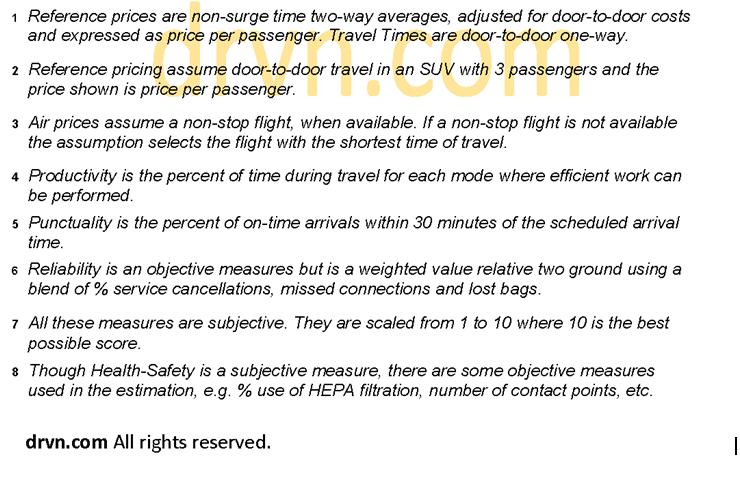“Two roads diverged in a wood and I – I took the one less travelled by.”
Robert Frost
Travel in particular, and transportation in general, are undergoing structural change, which gives rise to the questions above that are explored in this blog. Much of this change comes from challenges imposed by COVID-19. But some come from changes in how companies, their respective teams and employees interact. One good example that has been with us for a while is video-conferencing as an alternative to in-person meetings. With respect to travel, video-conferencing is still the only reasonable alternative to medium-haul air travel (distances over 500 miles) and long-haul air travel (over 1500 miles). In this blog, you will learn about the advantages and disadvantages of the transportation modes available for intercity travel between destinations separated by short-haul air (distances under 500 miles).
In our years serving business travelers and corporate travel managers, we have found that business travel professionals choose a transportation mode for point-to-point service based upon weighing a number of key factors. The most frequently used business travel category is intercity travel – specifically, those routes, which are between 2 and 6 hours in door-to-door drive time or between 150 to 400 miles in flight distance. These routes happen to have the greatest number of factors, which travel managers must consider before selecting the mode(s) of transportation for a trip.
We identify below a set of ‘preferred’ attributes that companies explicitly or implicitly use to evaluate transportation options. These key factors are the ones we, here at driven, have found to be the most common considerations used when making travel decisions. A number of studies have also concluded that these are the main factors (the first nine-plus Health-Safety) for mode choice that business travel decision-makers use.
These attributes are:
- Price – calculated as the lowest all-in cost where: 1) the air or rail price = ticket price + door-to-door ground transportation cost to and from an airport or rail station, and 2) the ground price = the door-to-door total ride cost.
- Travel Time – calculated as door-to-door total time of travel.
- Productivity – calculated as the percent of Travel Time available to focus on, and be unimpeded for work.
- Punctuality – the percentage of times a mode has on-time arrival (does not include on-time departures).
- Reliability – service cancellations, flight delays, schedule changes and other consistency measures.
- Convenience – this is a combination of subjective measures: 1) the ease of accessing airports (or rail stations) from a pick-up point and to a drop-off point, and 2) the ability to have team members travel together and productively interact.
- Schedule – as measured by the frequency and number of daily departures – an objective measure, but which is subjective based on passenger flexibility.
- Comfort – roominess, wifi availability, access, seat comfort, food choices, and other subjective feel-good amenities.
- Luggage – relative limits, handling considerations, baggage fees, lost bags and other baggage constraints. This is also a subjective measure based on passenger preferences and level of importance.
- Health-safety – this is somewhat anecdotal as health-safety measures vary by transportation mode and by the individual providers. However, each mode has its advantages and disadvantages with respect to passenger health risks in their respective environment.
For travel decision-makers, it is very likely that health-safety is now the most important factor to consider for choosing modes of travel. Whether health-safety as a criterion is temporary or represents a fundamental social and policy shift remains to be seen. Given conversations with travel managers, administrators, and planners, it is our guess that health-safety will remain a significant priority well into the future. Regardless, it will remain a strong consideration and ranks at or near the top of the list of priority attributes for the foreseeable future. Accordingly, we have included it in how we rank the different modes of short-haul transportation.
In evaluating these attributes, it would be wise to include broad demographic reference points as a perspective for assigning value. The primary demographic drivers for business travel are age and profession:
- A typical business traveler is likely to be 30 to 49 years old where 53% of all business trips are made by individuals (58% men and 42% women) in that age group.
- Those who consider their occupation to be professional, managerial, or technical account for over half (55%) of all business trips.
Given these two key usage demographics, age and profession, which also happens to be the chauffeured service industry’s primary demographic, we first ranked the objective data; Price, Travel Time, Productivity and Reliability using the metrics as stated.
For the remaining 5 subjective measures, everyone will have an opinion, including you, as to their relative value and importance. Regardless, we used objective criteria to look at each subjective measure.
- For Convenience, an important measure is the number of intermodal changes (car to the airport to tram to plane to car…). The greater number, the greater the inconvenience and greater the possibility for travel disruption.
- With Schedule, we used the relative frequency of air and rail departures against the ‘any-time’ schedule offered by ground.
- Comfort is probably the most subjective measure and includes things like proximity to other travelers, seating, amenities, and so forth.
- Luggage also has a few objective measures, baggage fees, lost bag percentages, but overall it is subjective based on passenger preferences.
- Health-Safety measures are now well known, e.g. limiting touchpoints, avoiding crowds, and minimizing proximity to other passengers. These are somewhat subjective based on how passengers observe these as well as a passenger’s personal health risk profile.
One final clarification point (referenced above) is that ground transportation by private car is a door-to-door service with an all-in price. For air and rail, the factors of Price, Travel Time, and Productivity must be adjusted, as noted above, to reflect the true door-to-door cost of travel.
Now onto the results.
A couple of interesting things our research has shown is that short-haul air travel is often longer than rail or ground – the average short-haul flight with door-to-door travel is 3 hours and 25 minutes. Travel Time more than doubled actual flight time when including door-to-door (point-to-point transfer) travel to and from the airport, airport check-in time, wait time at the airport, time waiting for baggage, and so on.
A couple of interesting things our research has shown is that short-haul air travel is often longer than rail or ground – the average short-haul flight with door-to-door travel is 3 hours and 25 minutes. Travel Time more than doubled actual flight time when including door-to-door (point-to-point transfer) travel to and from the airport, airport check-in time, wait time at the airport, time waiting for baggage, and so on.
Another interesting observation is that even with travel costs added to and from a station, rail is substantially cheaper than both ground and air. But not surprisingly, it also has the lowest Health-Safety rank and with fewer route options, ranks lower inconvenience.
What is clear from the above data is that ground is a far better choice for business travel than air or rail for routes between 2 hours and 5 hours long. Key considerations of productivity and health-safety make ground transportation far and away from a better choice than either air or rail. It is the only Price where the ground shows a lower value (for rail).
Lastly, there is one additional attribute we did not use in this analysis, but it is a factor that more and more companies are taking seriously. That is climate change and the carbon footprint per passenger for all transportation modes. We did not include it as a metric for this analysis as its level of importance is not evenly distributed across businesses. We expect that to change over time as carbon policy will likely move towards impacting businesses economically. Nonetheless, it is still worth mentioning that per passenger travel by:
- Air emits 133 grams of CO2 per hour of flight time (roughly the short-haul distance);
- Rail emits 41 grams of CO2 over that average short-haul distance, and;
- Ground (using an SUV with 4 passengers excluding the driver) emits about 48 grams of CO2. Rail is the winner here followed closely by Ground.
Intercity travel by ground is the new go-to service for corporate clients looking to manage small to large teams or groups traveling under 5 hours. Today with COVID, we have seen a significant uptick in reservations for even longer distances. Intercity travel using ground also impacts others traveling as groups such as sport teams and families. We invite you to come to explore drvn’s intercity solutions on the short-haul section on the DRVN website.
“When you come to a fork in the road, take it.”









